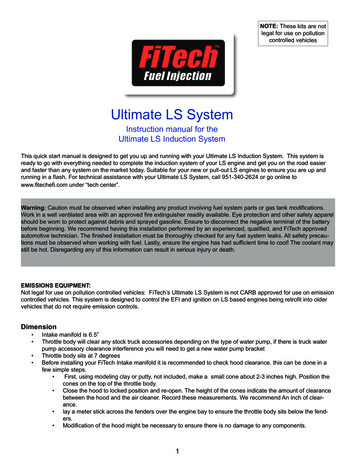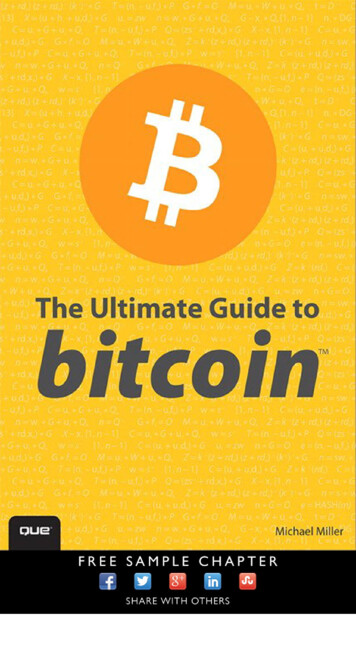
Transcription
- A PUBLICATION OF ALBERT.IO -AP CHEMISTRYThe UltimateStudent's Guide toAP ChemistryEVERYTHING YOU NEED TO GET STARTED*AP and Advanced Placement are registered trademarks of the College Board,which was not involved in the production of, and does not endorse, this product.
Ready to get a 5?Stop stressing about the AP Chemistry exam.Albert has got your back!With thousands of practice questions, personalizedstatistics, and anytime, anywhere access, Albert helpsyou learn faster and master the difficult concepts youare bound to see on test day.Click below or visit www.albert.ioStart Practicing
TABLE OF CONTENTS7Introduction8About Us11The Ultimate Guide toAtomic Structure andPeriodicity34The Ultimate Guide toStoichiometry
TABLE OF CONTENTS66How to Calculate anEmpirical Formula71Quantum Numbersand Theory88The Ideal Gas Law96R Value in Chemistry104Le Chatelier’s Principle
TABLE OF CONTENTS110The Ultimate Guide toSolubility Rules125The Ultimate Guide toElectrochemistry142How To BalanceRedox Reactions151IdentifyingAcids and Bases162Enthalpy vs. Entropy
TABLE OF CONTENTS177Gibbs Free Energy186The UltimateAP Chemistry EquationSheet203How to Study for APChemistry217The Ultimate List of APChemistry Tips
IntroductionAP Chemistry is no walk in the park. Some AP courses have a ton of content, someare conceptually difficult, but AP Chem is both. That’s why this is our largest, mostcomprehensive AP subject eBook yet.Here you’ll find an expansive library of guides designed to refine your conceptualknowledge and ability to solve AP problems. We’ve also packed in our UltimateList of AP Chemistry Tips as well as a How-to Guide for studying.It features information from the Albert Blog. If you’re looking for additionalresources, be sure to regularly check the blog and subscribe to hear about ournew posts. Even as we release this eBook, there are several great chemistryguides nearing publication on the blog. We’ve also got content for all of yourother APs, your college entrance exams, and even college coursework.E-mail us at hello@albert.io if you have any questions, suggestions, or comments!Interested in an Albert license? E-mail us at schools@albert.io7
About UsWhat is Albert?Albert bridges the gap between learning and mastery with interactive contentwritten by world-class educators.We offer: Tens of thousands of AP-style practice questions in all the major APs A complete competitive online leaderboard to see where you standcompared to others Immediate feedback on each question answered An easy to access platform from any Internet-enabled device In-depth personal statistics to track your progress Intuitive classroom tools for teachers and administratorsInterested in an Albert license? E-mail us at schools@albert.io8
Why Educators Love UsWe asked teachers how their students did after using Albert.Here is what they had to say:My students had an 81.2% passing rate - the previous year was 76%(the highest rate in our county)! I am thrilled. I had 64 students total,with 6 receiving 5s, 19 scoring 4s, 27 receiving 3s, 10 scored 2s and 2received 1s.Susan M., JP Taravella High70% of my students scored 3 or higher. This is up from last year, and isalso well above the national average. Needless to say, I am veryhappy with my students' success. I used Albert more intentionally thisyear. In the beginning of the year, I wanted students simply to answerquestions and practice. Once they had 150-200 questions answered,we looked for trends, strengths, and weaknesses and worked onaddressing them. Students were tasked with increasing their answeraccuracy no matter how many questions it took, then they set theirown goals (some wanted to focus around tone; others neededpractice with meaning as a whole).Bill S., Lapeer High SchoolLast year 40% passed with 3s and 4s. This year 87% passed, most had4s and 5s. We used the stimulus-based multiple choice questionsthroughout the year and as review for the exam. I think it helpedtremendously.Alice P., First Baptist Christian AcademyInterested in an Albert license? E-mail us at schools@albert.io9
Why Students Love UsWe asked students how they did after using Albert.Here is what they had to say:I scored very well this year – four 5s and one 4. Albert helped me getused to the types of questions asked on the exam and overall myscores were better this year.Robyn G., Chambersburg Area Senior High SchoolLast year was my first year taking an AP test, and unfortunately I didnot do as well as I had hoped. The subject had not been my best, andthat was definitely displayed on my performance. However this year, Imade a much higher score on my AP test. The previous year had beenAP World History and I had made a 2. For this year it was AP EnglishLanguage, and I scored a 4. There was a definite jump in my score,because Albert pushed me to focus on my weaknesses and form theminto strengths.Charlotte R., Rome HighI scored a 4 on AP Biology, much higher than expected. Albert was aneffective resource to guide me through AP Biology. Keeping up with itconsistently all year as I learned the lesson in class was crucial toreinforcing my understanding and long-term memorization of Biology.After class each day, Albert helped to sink in the ideas that I wastaught in the morning.Lily O., Wake Forest High SchoolInterested in an Albert license? E-mail us at schools@albert.io10
The Ultimate Guide toAtomic Structure andPeriodicityImage Source: Wikimedia CommonsHaving grown up in the 21st century, you probably know that everything aroundyou is fundamentally made of atoms. The chair you’re sitting on, the screen you’relooking at, and even the eyes you see with are made up of many different kinds ofatoms. But what are atoms? What do they look like? And more importantly, howcan I understand atomic structure for my AP Chemistry Exam? In this UltimateGuide, we’re going to give you a little bit of background on each topic to get youexcited about it, and then I’m going to give you tips and advice on what youshould memorize (or not), how to eliminate wrong answers quickly, and key wordsthat you should use in the long- and short-answer section of the exam.Interested in an Albert license? E-mail us at schools@albert.io11
The Ultimate Guide to Atomic Structureand Periodicity Cont.We will first start our discussion with a brief overview of the wave-like natureelectromagnetic radiation. We will then go on to discuss the particle-nature ofmatter and how the discoveries in the early 20th century shaped ourunderstanding of the atomic structure and spectrum of the hydrogen atom. We’lldiscuss Bohr’s model of the atomic structure of the hydrogen atom, and thequantum mechanical model for atomic structure. We will dive into an explanationabout the quantum numbers and their physical interpretations, and we will finishup this article with an overview of how atomic structure influences periodicity andperiodic trends in the periodic table. Kapische? Let’s go!Electromagnetic Radiation – Essential Knowledge 1.D.3.No discussion of atomic structure is complete without first understanding whatElectromagnetic Radiation is. An examples of electromagnetic radiation is thevisible light that you see coming off your screen and hitting your eyes, givingobjects color and visibility. Electromagnetic radiation also makes up the radiowaves travelling to our cars and the WI-FI signal going to our phones andcomputers.Image Source: Wikimedia CommonsInterested in an Albert license? E-mail us at schools@albert.io12
The Ultimate Guide to Atomic Structureand Periodicity Cont.But clearly, there is a big difference between visible light and your WI-FI signal.What is that difference? All types of electromagnetic radiation can be described interms of two variables: their wavelength, and their frequency. Wavelength,denoted by the Greek letter lambda (λ) and measured in meters (m), is thedistance between two peaks in a wave. Visible light is an example of shortwavelength electromagnetic radiation, with wavelengths between 400-700nanometers (nm), or 1 billionth of a meter. Frequency, denoted by the Greekletter nu (ν) and measured in Hertz (Hz s-1), is a measure of how many times persecond the wave repeats itself. The higher the frequency of a wave, the higher theenergy of the wave. An example you can relate to is that exposure to X-rays (ν 1018 Hz) is much more harmful than exposure to FM radio waves (ν 108 Hz).Image Source: Wikimedia CommonsAnother feature of electromagnetic radiation is that all electromagnetic wavestravel at the speed of light (c 2.998 x 108 m s-1). This means that the product ofthe wavelength and frequency of an electromagnetic wave are always equal tothe speed of light, or:c λ x ν 2.998 x 108 m s-1Interested in an Albert license? E-mail us at schools@albert.io13
The Ultimate Guide to Atomic Structureand Periodicity Cont.This equation will be given to you on the AP Exam, so there’s no reason to try andmemorize it. It implies that frequency and wavelength are inverselyproportional to each other, meaning that as one variable increases, the otherdecreases correspondingly. You should have no trouble solving this equation witha simple algebraic rearrangement of variables.A great tip for quickly eliminating wrong answers on the Multiple Choice and forchecking your answers on the Free Response section is to focus on the exponents.Since the product of the variables must have an exponent of108 (the speed oflight), it makes sense that if the known variable has a large positive exponent(e.g. λ 8 x 1015m), the corresponding variable must have a negative exponent (inthis case, ν 3.75 x 10-8 Hz). This approach will help you instantly eliminate atleast two wrong answers on the Multiple Choice, and will save you valuable timecrunching numbers on the Free Response.This understanding of the relationship between frequency, wavelength, and thespeed of light was one of the fundamental discoveries that paved the way towardsan understanding of the atomic nature of matter. Now that we understand thewavelike nature of light, let’s move on the particle-like nature of light! Soundscrazy? You don’t even know!Nature of Matter – Essential Knowledge 1.B.1, 1.D.3.Towards the end of the 19th Century, a series of experiments were bafflingphysicists from around the world and challenging their understanding of thenature of matter. One of them was known as the Blackbody Radiation. Ablackbody is an idealized object that absorbs all incoming frequencies ofelectromagnetic radiation, approximated by a small slit in a large black box.Interested in an Albert license? E-mail us at schools@albert.io14
The Ultimate Guide to Atomic Structureand Periodicity Cont.A blackbody emits electromagnetic radiation at frequencies entirely based uponits temperature, and the classical model of light as waves was unable to accountproperly for the wavelengths of light being emitted!Image Source: Wikimedia CommonsTo explain these results, German Physicist Max Planck (1858 – 1947), also knownas the Father of Quantum Theory, theorized that, instead of matter being able toemit at infinite frequencies of electromagnetic radiation, there was some limit asto the frequency that light could be emitted or absorbed at. In other words, hethought of the emission frequencies coming out of matter as a series of stepsrather than a smooth ramp. For everyday objects, energy can take on any arbitraryvalue. However, Planck theorized that for small objects, the energy being emittedby objects was more like a staircase, where it could only come in discrete packetshe called quanta. In other words, the energy released from objects is quantized, aphenomenon which eventually to what we know as the Quantum Theory ofMatter. It turns out, the nature of matter is quantized! Planck, throughmathematical derivation, arrived at what we now call Planck’s Constant (h), whichis the smallest unit of Energy that can be gained or lost by atoms, in units of Joules(energy) times second (time), where:h 6.626 x 10-34 J s.Interested in an Albert license? E-mail us at schools@albert.io15
The Ultimate Guide to Atomic Structureand Periodicity Cont.This should seem strange – it’s like saying that a car can only travel at specificspeeds! Even after his discovery, Planck was unconvinced that this constant wasanything other than a theoretical mathematical artifact. It was, in fact, AlbertEinstein (1879 – 1955) who was able to explain the importance of this discovery.Many people think that Einstein was given the Nobel Prize in Physics for his workson Special Relativity. In fact, Einstein was awarded the Prize for figuring out thecause for the Photoelectric Effect. This effect was an experimental observationthat, when you shone a light on a piece of metal hooked to a current meter, onlyelectromagnetic waves above a certain frequency (regardless of the energy) causeelectrons to be released from the surface of the metal.What made this observation even more interesting was that this was trueregardless of the energy the light possessed. Einstein, using Planck’s QuantumTheory, hypothesized that the electromagnetic radiation hitting the metal was infact composed of many small particles, which he called Photons, and the energyof these photons was directly related to the frequency of the electromagneticwave by the following relationship:Ephoton hv, where h 6.626 x 10-34 Js and the frequency is in units of Hz.Interested in an Albert license? E-mail us at schools@albert.io16
The Ultimate Guide to Atomic Structureand Periodicity Cont.And using the previous relationship we learned about frequency and wavelength,this equation can also be interpreted as,The AP Exam will almost certainly contain some questions about this topic. So let’sreview some common pitfalls.Classic expectation: a high enough intensity of light, regardless of frequency,should could electrons to be ejected. WRONG!Quantum Explanation: Light itself comes in little packets of energy called Photons.At a specific wavelength, photons have a specific amount of energy, and onlyphotons with enough energy, regardless of intensity, can knock out electrons.Atomic Spectrum of Hydrogen – Essential Knowledge 1.D.3.The final experiment which demonstrated to physicists that the classicalexplanation of “electromagnetic radiation as waves” was incomplete was theatomic spectrum of Hydrogen. If you put hydrogen gas in a tube and run a lot ofelectricity through it, it will emit light.Image Source: Wikimedia CommonsInterested in an Albert license? E-mail us at schools@albert.io17
The Ultimate Guide to Atomic Structureand Periodicity Cont.Classical explanation would predict that the light being emitted is a continuousspectrum containing all frequencies of light. However, that is not the case.Hydrogen emits light in what is called a Line Spectra, meaning, light is onlyemitted at discrete wavelengths.Image Source: Wikimedia CommonsSounds familiar? That’s because the quantum nature of matter can be used toexplain the atomic spectrum of hydrogen! If we assume that hydrogen atoms canonly emit photons of quantized energy, with the energy of each photon being,Ephoton hnν, where n is a positive integer valueWe find that the frequencies of emitted light exactly match those calculated bythe equation! In fact, the integer n is our principal quantum number!Interested in an Albert license? E-mail us at schools@albert.io18
The Ultimate Guide to Atomic Structureand Periodicity Cont.One thing to keep in mind is that on the AP Exam you may be given eitherfrequency or wavelength for this calculation, so don’t forget to use therelationship previously discussed to convert between them.Image Source: Wikimedia CommonsBohr Model – Science Practice 1.3, 3.3.The classical model of atomic structure assumes that the negatively-chargedelectrons orbit the positively charged nucleus at any arbitrary radius away fromthe nucleus, like planets in our solar system orbiting around the sun. DanishPhysicist Niels Bohr (1885-1962) used the derivation of the principal quantumnumber of the hydrogen line spectra to revise this Classical Model of the Atom. Heproposed that the electrons could only orbit the nucleus at discrete radii that hecalled Shells, and electrons in shells further away from the nucleus possessedmore energy.Interested in an Albert license? E-mail us at schools@albert.io19
The Ultimate Guide to Atomic Structureand Periodicity Cont.He proposed that the line spectrum of hydrogen was caused by the transition ofelectrons from one shell to another!Image Source: Wikimedia CommonsWhile this is certainly an attractive picture, these quantum calculations haveshown us that this theory is in fact wrong! In Bohr’s model, electrons are stillbasically particles orbiting the nucleus. For various reasons we will not get into,this assumption simply cannot be true. In 1924, French Physicist Louis de Brogliepresented his doctoral thesis (which was only two pages long!!!) proving thatlight, and in fact ALL particles, are inherently both particles and waves at the sametime. This is known as the Wave-Particle Duality and was the breakthroughexplanation necessary to explain how light, which clearly acts as a wave, can alsoact as a particle with quantized energy.Interested in an Albert license? E-mail us at schools@albert.io20
The Ultimate Guide to Atomic Structureand Periodicity Cont.Quantum Mechanical Model of the Atom – 1.B.1, 1.C.2.This leads to a very strange implication: all objects are inherently fuzzy. And whilemacroscopic objects like cars have immeasurably small wavelengths, electronshave wavelengths that are measurable. It was for this reason that ErwinSchrödinger (1887 – 1961) proposed a series of mathematical equationscalled Wave Mechanics which showed that all subatomic particles behaveaccording to a set of Quantum mathematical equations called wavefunctions. Rather than orbiting the nucleus in so-called Planetary Motion,electrons actually orbit the nucleus as an Electron Cloud. A feature of the electroncloud is that they are in fact Areas of Probability for locating electrons (the cutoffis 90% probability).Image Source: Wikimedia CommonsInterested in an Albert license? E-mail us at schools@albert.io21
The Ultimate Guide to Atomic Structureand Periodicity Cont.The Quantum Mechanical Model of the Atom treats all electrons as if they orbitthe nucleus as a standing wave. An example of a standing wave is a guitar string,which, when plucked, vibrates at a certain harmonic frequency. In the same sense,electrons vibrate around the nucleus at a certain harmonic frequency. Animportant property of a standing wave is it does not propagate through space,and therefore, must always equal a whole number integer such that the endsmeet at both sides. Here are two visual examples, one of a string as a standingwave, the other of a circle as a standing wave.Image Source: Wikimedia CommonsImage Source: Wikimedia CommonsInterested in an Albert license? E-mail us at schools@albert.io22
The Ultimate Guide to Atomic Structureand Periodicity Cont.In the second image on the right, we see an example of an impossible standingwave. It is impossible because only waves of certain frequencies match upcorrectly at each end, and form a complete circle.Key Fact to Remember: It is these mathematically correct waves, knownas harmonic frequencies, which correspond to the principal quantumnumber n previously discussed.Quantum Numbers – Essential Knowledge 1.C.2.The Quantum number n is one of four quantum numbers that are used todescribe an electron in an atom. When given all four quantum numbers, wepossess all the information necessary to describe atomic structure of an electronin an atom. The quantum numbers of an electron are: Principal Quantum Number(n); quantum of angular momentum (l); the magnetic quantum number (ml); andthe spin quantum number (ms). Don’t get confused by the terminology. For thesake of the Exam, try to keep things as simple as possible. You won’t be providedwith any of this information explicitly, so it is important to understand thisinformation as much as possible. Think about the flow from one quantum numberto the next, and most importantly, don’t panic!Table1. Quantum Numbers for each of the first four shells.Quantum Numbers for the First Four ShellsnlOrbital DesignationmlNumber of Orbitals101s01202s0112p-1, 0, 13Interested in an Albert license? E-mail us at schools@albert.io23
The Ultimate Guide to Atomic Structureand Periodicity Cont.Quantum Numbers for the First Four ShellsnlOrbital DesignationmlNumber of Orbitals303s0113p-1, 0, 1323d-2, -1,0, 1, 2504s0114p-1, 0, 1324d-2, -1,0, 1, 2534f-3, -2,-1, 0,1, 2, 374The first quantum number, previously discussed, will tell you the harmonic wavefunction that corresponds to the electron, and it must be a positive integer valuegreater than zero. The greater n is, the greater the average radius of the electronis from the nucleus.This has two important ramifications. First: the higher n is, the further away theelectron is from the nucleus (i.e. the larger the circumference of its path), and thehigher the energy of the electron is. Bigger (n) Larger Energy. Second: the higherthe quantum number, the less tightly bound the electron is, and the easier it is tobe removed. That means that in an atom, electrons with the highest principalquantum number are the ones most likely to be knocked out of the atom first!Interested in an Albert license? E-mail us at schools@albert.io24
The Ultimate Guide to Atomic Structureand Periodicity Cont.This effect is due to the shielding of the electrons from the positive charge of thenucleus due to successive layers of electron shells, like magnets of like-polerepelling each other.n Any Positive Integer [1, 2, 3, ]Angular momentum is a physical property that any orbiting object possesses. Fora classical macroscopic object, angular momentum can take on any arbitraryvalue. However, as per the theme of this Guide, electrons can onlypossess quantized angular momentum. The values of angular momentum that anelectron may possess are entirely determined by the principal quantumnumber n of the electron.Possible values of Angular Momentum (l): 0 l (n – 1).Let’s look at an example.If the electron of a hydrogen atom is in the first shell, what is its principal quantumnumber and what possible values of angular momentum can it possess?In this example, the electron is in the first shell, meaning that n 1.For n 1, 0 l [(1) -1] à 0 l 0; in other words, l can only equal 0.Interested in an Albert license? E-mail us at schools@albert.io25
The Ultimate Guide to Atomic Structureand Periodicity Cont.As you have probably seen before, each value of l corresponds to an orbital“name” given in the table below. IT IS IMPORTANT TO REMEMBER THESE NAMES:Table 2. The given names of each of the common orbitals.Angular Momentum Value (l)0123Given NamespdfThe third quantum number is called the Magnetic Quantum Number and isdenoted ml. The easiest way to think about this quantum number is to rememberthat it dictates Method of Leaning, or in regular English, the orientation of theorbital in space. Although the orientation doesn’t exactly depend on the valueof ml, for our purposes the comparison is sufficient. For example, while the sorbital (ml 0) is spherical, meaning no orientation, the p-orbital (ml -1, 0, 1) iscomposed of three pairs of lobes, each of equal energy and oriented about one ofthe principal axes x, y, or z.Image Source: Wikimedia CommonsInterested in an Albert license? E-mail us at schools@albert.io26
The Ultimate Guide to Atomic Structureand Periodicity Cont.Electron Spin – Essential Knowledge 1.C.2.The final quantum number is called the Electron Spin and is denoted ms. Let’s goback to the analogy of electrons as planets for a second. In this analogy, theelectrons revolve around the nucleus, and the distance, speed, and direction ofrevolution are determined by the first three quantum numbers. However, there isanother type of motion that the planet undergoes; rotation. The planet, or in thiscase the electron, rotates around itself. This rotation is an intrinsic property notjust of electrons, but of all subatomic particles. Without getting into too manydetails, you’ll just have to accept it as a fact that the spin of all electrons is eitherplus or minus ½. The difference between positive and negative spin is akin tothinking about the earth either facing with the North Pole “Up” or “Down”. Let’sreview the quantum numbers one more time before moving before moving on.Table 3. A quick review of the quantum numbers and their meaning.SymbolQuantum NumberExplanationnPrincipalDetermines electron energyand orbital size.lAngular MomentumIdentifies orbital shape.mlMagneticIdentifies orbital orientation.msSpinIdentifies one of two possiblespin states.Interested in an Albert license? E-mail us at schools@albert.io27
The Ultimate Guide to Atomic Structureand Periodicity Cont.Electron Configuration – Essential Knowledge 1.B.2, 1.C.1.As Chemists, what we need to know is that no two electrons in an atom may havethe same set of four quantum numbers. This means that only two electrons mayoccupy a given orbital (ms ½). This concept is known as the Pauli ExclusionPrinciple. We denote the electron with the positive spin as an arrow facing up,and the electron with the negative as an arrow facing down. This is expressedvisually as,Electrons occupy the lowest-energy levels of an atom first. So, when trying tofigure out the electron configuration of an atomic structure, we would fill out thelowest energy orbital (1s) before moving on to the next highest orbital (2s) and soon. This observation is known as the Aufbau Principle. Aufbau means “buildingup” in German, and it refers to the order in which we as chemistry students“build-up” the electrons in an atomic structure. There are many mnemonicdevices that help you memorize this diagram, but we find it easiest to memorizethe exceptions rather than the rule;3d is between 4s and 4p4d is between 5s and 5pFor n 6, the energy goes: 6s 4f 5d 6p.Interested in an Albert license? E-mail us at schools@albert.io28
The Ultimate Guide to Atomic Structureand Periodicity Cont.Another important thing to remember when applying the Aufbau principle isHund’s Rule; that we obtain the lowest energy configuration of an atom by havingthe maximum number of unpaired electrons in so-called “degenerate” orbitals.Degenerate orbital is another word for orbitals of equal energy, i.e. the three 2porbitals or the five 3d orbitals. So for an atom with enough electrons to fill fivespots in the d-orbital (i.e. Manganese, atomic number 25), the lowest energyconfiguration would be to have each orbital with 1 electron.Image Source: Wikimedia CommonsWith that, we have finished covering the general details of atomic structure! Withthe information provided hitherto, you should be able to answer any MultipleChoice question on the topic of atomic structure, and to provide a reasonablydetailed answer on the Free Response section. With this information at hand, wecan now discuss periodic trends in the Periodic Table of the Elements, whoseconversation without this quantum knowledge would have been incomplete. Let’sbegin with a quick historical conversation, and then move on the Periodic Tableitself.Interested in an Albert license? E-mail us at schools@albert.io29
The Ultimate Guide to Atomic Structureand Periodicity Cont.Periodicity – Essential Knowledge 1.C.1, 2.D.3.The science of Chemistry emerged as an independent field of science after theexperiments of French scientist Antoine Lavoisier (1743-1794), who is mostfamous for formulating the Law of Conservation of Mass. Among his less widelyknown accomplishments, however, was his discovery of the chemical constituentsof the air, such as Nitrogen and Oxygen. His research on the elements paved theway for Russian Chemist Dmitry Mendeleev (1834-1907), who discovered that ifhe rearranged the elements according to their mass, he was able to findsimilarities in their chemical properties. However, he couldn’t explain why thisrelationship existed.Image Source: Wikimedia CommonsWe now know, however, that what he was seeing was the periodicity in theatomic structure of the elements. For example, all elements in the first column ofthe periodic table have one electron in their s-orbital.Interested in an Albert license? E-mail us at schools@albert.io30
The Ultimate Guide to Atomic Structureand Periodicity Cont.This electron configuration gives the atom certain chemical traits that are clearlydistinguishable from chemicals in other columns of the period table. So whatMendeleev discovered was in fact that if we order the elements in order of theirvalence, or outermost, electrons, we discover elements with recurring chemicalproperties. This concept is known as Periodicity, or Periodic Trends.Periodic Trends – Essential Knowledge 1.C.1.There are other periodic trends besides chemical reactivity. The number andposition of valence electrons determines the ionization energy (the energyrequired to remove an electron from an atom, or to ionize it into a 1 positiveion), the electron affinity (how attracted the element is to gaining anotherelectron), atomic radius (the average radius of an atom, measured as half thedistance between radii in a covalently bonded diatomic molecule), and metalliccharacter (metals are solid and brittle, nonmetals are gaseous and pliable). Theway these periodic trends play out are all neatly summarized in the image below:Image Source: Wikimedia CommonsInterested in an Albert license? E-mail us at schools@albert.io31
The Ultimate Guide to Atomic Structureand Periodicity Cont.You’ll have a Periodic Table on the AP Exam, and I’ve provided you with one hereas well. The important thing is not to memorize exact examples, but rathe
AP Chemistry is no walk in the park. Some AP courses have a ton of content, some are conceptually difficult, but AP hem is both. That [s why this is our largest, most comprehensive AP subject eBook yet. Here youll find an expansive library of guides designed to refine yo











